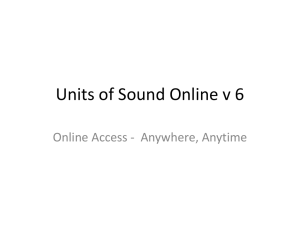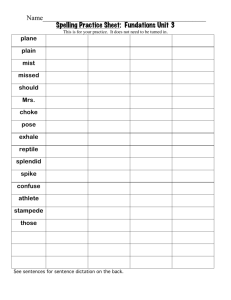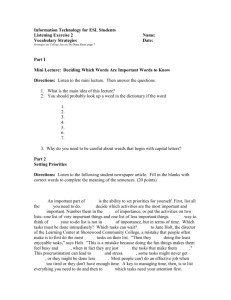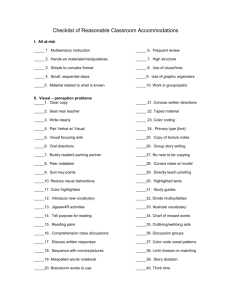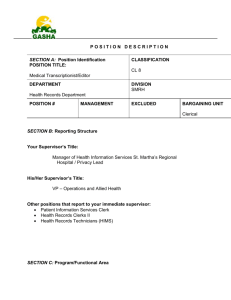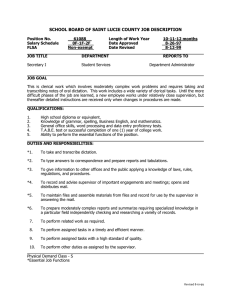CITY UNIVERSITY CURRICULUM COMMITTEE
advertisement
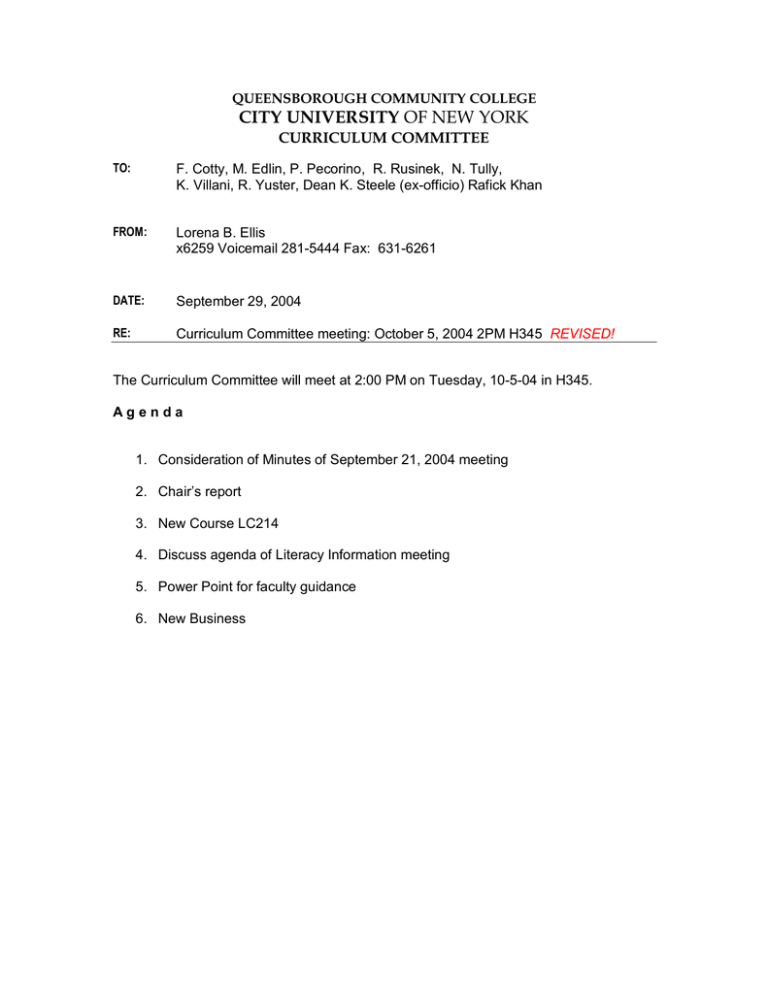
QUEENSBOROUGH COMMUNITY COLLEGE CITY UNIVERSITY OF NEW YORK CURRICULUM COMMITTEE TO: F. Cotty, M. Edlin, P. Pecorino, R. Rusinek, N. Tully, K. Villani, R. Yuster, Dean K. Steele (ex­officio) Rafick Khan FROM: Lorena B. Ellis x6259 Voicemail 281­5444 Fax: 631­6261 DATE: September 29, 2004 RE: Curriculum Committee meeting: October 5, 2004 2PM H345 REVISED! The Curriculum Committee will meet at 2:00 PM on Tuesday, 10­5­04 in H345. A g e n d a 1. Consideration of Minutes of September 21, 2004 meeting 2. Chair’s report 3. New Course LC214 4. Discuss agenda of Literacy Information meeting 5. Power Point for faculty guidance 6. New Business 3. New Course LC214 New Course Proposal Guidelines / Template (Att.4 in Guide) LC­214 1. Course prefix and number: 2. Course title: Intermediate Chinese II 3. Course description for the college catalog: The focus of this course is to continue the improvement of oral communication skills, along with reading, writing, and grammar. It is designed to help students expand their vocabulary, and to study more complex grammatical structures. Components of Chinese culture will be integrated through readings, discussions and realia. 4. Prerequisites and/or co­requisites: LC­213 or permission of the department, if a student takes this course as a second semester of foreign language requirement. Otherwise, none. 5. Hours and credits (specify if class hours, lab. hours, 3 class hours 3 credits recitation hours, etc.) 6. Curricula into which the course would be incorporated and the requirements it will satisfy: This course will fulfill foreign languages requirements in all curricula which require foreign language study. 7. Curricular objectives addressed by this course. See General Education objectives 8. General Education objectives addressed by this course. [see QCC Educational Objectives statement in college catalog] · write, read, listen, and speak clearly and effectively. · use personal and collaborative skills for personal growth and to establish constructive relationships in a diverse society. · differentiate and make informed decisions about issues based on value systems (ethical, philosophical, religious, cultural, and political). 9. Course objectives / expected student learning outcomes. a. Further improve pronunciation and tones in Chinese. b. Understand and use the grammar contained in the second half of Level 2 of Integrated Chinese. c. Read Chinese texts written with approximately 1,200 characters. d. Learn around 400 traditional and simplified characters. e. Be able to speak Chinese with some fluency on everyday topics. f. Be able to write short compositions. 10. Assessment – methods used to determine the success of students (whether or not they achieved the goals and developed the competencies) [see Assessment template]: Quizzes on characters (20%), lesson tests (25%), attendance/class participation/homework (20%), oral exam/presentation (10%), final exam (25%). 11. A detailed course outline showing main topics of the course (include a laboratory outline when applicable) [see Recommended Syllabus template]: Week 1: Course overview, language background survey, review Week 2: Lesson 11, dictation on first­half of vocabulary, dictation on second­half of vocabulary, grammar, speaking activities from pattern drill, read characters in text, questions and answers of the text. Week 3: Lesson 11 cont. Roleplay activity of the dialogue. Homework discussion. Test of Lesson 11. Week 4: Lesson 12, dictation on first­half of vocabulary, dictation on second­half of vocabulary, grammar, speaking activities from pattern drill, read characters in text, questions and answers of the text. Week 5: Lesson 12 cont. Roleplay activity of the dialogue. Homework discussion. Test of Lesson 12. Week 6: Lesson 13, dictation on first­half of vocabulary, dictation on second­half of vocabulary, grammar, speaking activities from pattern drill, read characters in text, questions and answers of the text. Week 7: Lesson 13 cont. Roleplay activity of the dialogue. Homework discussion. Test of Lesson 13. Lesson 14, dictation on first­half of vocabulary, dictation on second­half of vocabulary, grammar, speaking activities from pattern drill, read characters in text, questions and answers of the text. Week 8: Lesson 14 cont. Roleplay activity of the dialogue. Homework discussion. Test of Lesson 14. Week 9: Lesson 15, dictation on first­half of vocabulary, dictation on second­half of vocabulary, grammar, speaking activities from pattern drill, read characters in text, questions and answers of the text. Week 10: Lesson 15 cont. Roleplay activity of the dialogue. Homework discussion. Test of Lesson 15. Lesson 16, dictation on first­half of vocabulary, dictation on second­half of vocabulary, grammar, speaking activities from pattern drill, read characters in text, questions and answers of the text. Week 11: Lesson 16 cont. Roleplay activity of the dialogue. Homework discussion. Test of Lesson 16. Week 12: Lesson 17, dictation on first­half of vocabulary, dictation on second­half of vocabulary, grammar, speaking activities from pattern drill, read characters in text, questions and answers of the text. Week 13: Lesson 17 cont. Roleplay activity of the dialogue. Homework discussion. Test of Lesson 17. Lesson 18, dictation on first­half of vocabulary, dictation on second­half of vocabulary, grammar, speaking activities from pattern drill, read characters in text, questions and answers of the text. Week 14: Lesson 18 cont. Roleplay activity of the dialogue. Homework discussion. Test of Lesson 18. Week 15: Oral exam/presentation, and general review for the final exam. 12. Methods of Instruction (such as lecture, distance learning, the web, television, writing intensive): Lecture, drill, discussion, reading, writing, pair and group work, and oral presentation. 13. Texts, references and aids. A bibliography for the course and supplementary material, if any: Integrated Chinese, Level 2 (textbook, workbook, character workbook) by Tao­Chung Yao et al, Cheng & Tsui Company 14. Rationale – why the course is needed or desired; student demand; projected enrollment; how often it will be offered, etc. The predominant population in some parts of Queens is Chinese. This course not only serves the Chinese heritage students who would like to learn or improve upon their parents’ language skills, it also gives our diverse student body an additional and highly relevant language choice to fulfill their language requirement. Those students who are interested in pursuing Asian studies or studying Chinese literature will benefit from this course offering, as well as those who would like one day to conduct business with China or travel to China. Students may take Chinese to fulfill a degree requirement in foreign language. Enrollment of about 30 is expected the first time it is offered and it will be offered every other semester. 15. Transferability as an elective or course required by a major to senior colleges (with supporting documents if applicable). Include comparable courses at senior or other community colleges, if applicable: Proposal sent to Baruch, Hunter, Brooklyn College, York College, and Queens College to find out about transferability. 16. Faculty availability: The Department of Foreign Languages and Literatures has instructors available to teach the course. 17. Facilities and technology availability: All necessary facilities and technology are available. 18. List of courses to be withdrawn, or replaced by this course, if any: None 19. Enrollment limit and frequency the course is offered (each semester, once a year, alternating years): Enrollment is limited to 30 per session. The course will be offered every other semester. 20. What changes in any programs will be necessitated or requested as a result of this course’s additions/charges: none June 1, 2004 4. Discuss agenda of Literacy Information meeting Date: Tuesday, ___________ Time: 2pm Place: A504? ____________ Who: Aside from all curriculum Committee members the following people should be invited. Dr. Kyu Sund Kim, Prof. Sandra Marcus, Dr. Susan Sciammarella (Library); Dr. Jeffrey Kurnit (Basic Skills); Dr. Stanley Rustin (Studetn Affairs, with copy to VP Ellen F. Hartigan) I think that the new directors of CUE and CETL should be invited. Dr. Michael Roggow, director for the Coordinated Undergraduate Education or CUE initiative. Dr. Belle Gironda, Director of CETL What: A formal agenda on what this meeting is going to be on should be drafted before we invite the above guests. The agenda should have the following attachments: 1) PP “multi faceted approach”; 2) QCC Statement of educational Objectives; 3) Resolution on Information and Technological Literacy. Some questions: ­Clear definition: Literacy Information (invite Prof. Sandra Marcus do this?) ­What is being done now: ­ When courses are offered (Info. Literacy, ST100 and ST101) ­ What has been the enrollment in there courses How are we collecting information? ­Should academic integrity be part of this? ­Objective: What do we want students to achieve? ­Do we meet the need of our students? ­ etc. Please bring all your suggestions. 5. Power Point for faculty guidance 1. How to fill in new course proposal and new syllabus 2. Steps to certificate or degree program development working with the OAA.

